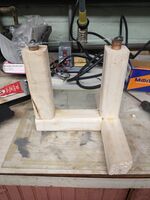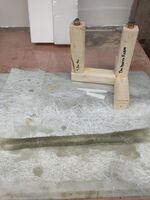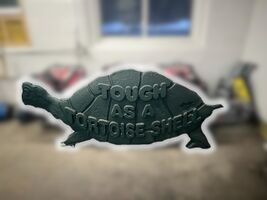Difference between revisions of "Foam Cutter"
(→CNC) |
(→CNC) |
||
| Line 35: | Line 35: | ||
====CNC==== | ====CNC==== | ||
There are two notes with regards to foam cutting, and cnc. One is that you can make a CNC foam cutter, but you will be limited as to what shapes you can make, as wire can't cut detail like a mill would. For a CNC mill and styrofoam, Here is an example of a 7'x 3' long tortoise one of our customer's CNC'd for us as a gift. Notice the fine details and features possible on the styrofoam. (Please excuse the unfinished gelcoat work. This is a work in process). For fine detail, a mill may be a better tool. The picture is a good representation of that. In fact, you might want to use both. A wire to cut large pieces off (even manually), followed by a mill for fine detail. | There are two notes with regards to foam cutting, and cnc. One is that you can make a CNC foam cutter, but you will be limited as to what shapes you can make, as wire can't cut detail like a mill would. For a CNC mill and styrofoam, Here is an example of a 7'x 3' long tortoise one of our customer's CNC'd for us as a gift. Notice the fine details and features possible on the styrofoam. (Please excuse the unfinished gelcoat work. This is a work in process). For fine detail, a mill may be a better tool. The picture is a good representation of that. In fact, you might want to use both. A wire to cut large pieces off (even manually), followed by a mill for fine detail. | ||
| + | <gallery widths=300px heights=200px> | ||
| + | File:Cnc tortoise.jpg|CNC Milled Tortoise. 7' x 3' roughly. | ||
| + | </gallery> | ||
Revision as of 22:24, 6 February 2024
It's easy to make a foam cutter out of only Nichrome resistance wire and an Adjustable Power Supply. Foam cutters are well documented online, and you will find no shortage of videos and articles. Here is my approach.
Items Needed
- Nichrome / Resistance Wire
- Voltage source, Ideally an Adjustable Power Supply
- Frame to hold the wire
- Styrofoam
Details of Items
Wire
When buying the Nichrome wire, you are dealing with fairly small wire. You don't want to buy wire that is too thick, as there will be no resistance, and the wire will just short your PSU. On the other hand you don't want to buy wire that is too thin, as it will be more likely to break. I bought 30 feet of 28 Gauge wire on ebay (4 ohms per foot), and it was about $7 delivered. This turned out to be a good size, and I guessed correctly when purchasing for the first time. But I'm also a bit of a wire collector, so I had some insight as to what would and wouldn't work. Experience with magnet wire will help here. It's possible to purchase Nichrome wire from official channels, as well if you are worried about quality (general Industrial distributors such as Mcmaster, or the electronics distributors, Mouser, Farnell's, Digikey). It's easy to find online. It's also very cheap. If you keep wire in inventory, there's no reason not to have some Nichrome wire. You may also be able to salvage it from hair dryers or portable heaters (from what I've read).
Power Supply
For the Power Supply, It's best to start with an Adjustable Power Supply, set the current to 1A or so, and then ramp up the voltage to where the wire just starts to cut through the styrofoam. I found with my PSU that with the 28 gauge wire of about half a foot, that 3V was all that was needed to get the wire to easily cut through the foam. There's no need to get the wire to be red hot or anything dramatic. It should at a voltage just slightly above where it is a bit hot to the touch through a latex or nitrile glove. If you only have a fixed 3.3V or 5V PSU, you are running things a little more dangerously, though it will likely be OK. So a 5V Power Brick of say 1A should work in a pinch. However, Variable Voltage Supplies can be found for <$50 and any type of lab or workshop should have one. I purchased mine for $30 from a local electronics surplus store.
Frame
For the frame, I glued together some non-conductive wood, let it sit overnight, and then just screwed down some washers over a piece of cut copper tubing. The wire is wrapped around the screw, and the washers have it make contact. The leads from the PSU connect to the copper tubing. It's extremely basic, but also extremely quick to make. This is just a proof of concept, and is not meant to be anything for production. It's just to demonstrate the viability of Nichrome wire to melt styrofoam.
Styrofoam
You can purchase small pieces of styrofoam from art stores for $4 or so (2024 dollars). For a test, these should work fine. Make sure to get traditional coffee cup styrofoam (Polystyrene) and not other types of plastic that look similar but are not styrofoam.
Images
Video Demonstration
Curing Notes
Do not use too much MEKP. For styrofoam, you want it to cure cool, which means it must cure slowly. Less MEKP will achieve this.
Conclusion
A foam cutter is a trivial but useful tool to use for cutting styrofoam. If you are working with fiberglass, and don't already have one of these, you are missing out. While this revision 1 was a quick hack, it is extremely easy to use, easy to make, and I think it will become a standard tool in my arsenal for glassing.
CNC
There are two notes with regards to foam cutting, and cnc. One is that you can make a CNC foam cutter, but you will be limited as to what shapes you can make, as wire can't cut detail like a mill would. For a CNC mill and styrofoam, Here is an example of a 7'x 3' long tortoise one of our customer's CNC'd for us as a gift. Notice the fine details and features possible on the styrofoam. (Please excuse the unfinished gelcoat work. This is a work in process). For fine detail, a mill may be a better tool. The picture is a good representation of that. In fact, you might want to use both. A wire to cut large pieces off (even manually), followed by a mill for fine detail.


